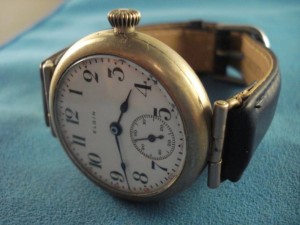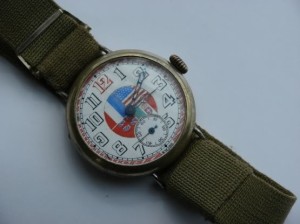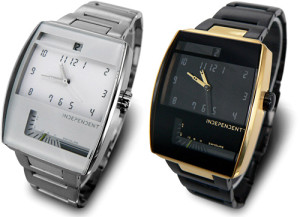First Wristwatch Ever Made
Watches popped up on the technology timeline in the 16th century, prompted by the invention of the mainspring. This simple piece of metal, coiled around an axle by the process of winding and allowed to uncoil at a regular rate, provided the kinetic drive.
The first portable timepieces were pocket watches which were worn on a chain; however, they only had an hour hand and they were terribly inaccurate, often losing several hours a day. Nevertheless, these were very much the commercial Rolexes of their time, ornate items valued primarily as status symbols. They weren’t very popular either, and it took another century before watches became a common sight.
The invention of the balance spring in the mid-17th century, which gave the mainspring a beat that was much more resistant to disturbances, brought with it the minute hand.
 Now watches were accurate to around a ten-minute margin for error a day and, with the realization that watches could be used as scientific instruments, throughout the 17th and 18th centuries improvements to the accuracy of the balance spring were facilitated by the scientific community. Jewel bearings were popularized in the early-20th century for accurate timepieces.
Now watches were accurate to around a ten-minute margin for error a day and, with the realization that watches could be used as scientific instruments, throughout the 17th and 18th centuries improvements to the accuracy of the balance spring were facilitated by the scientific community. Jewel bearings were popularized in the early-20th century for accurate timepieces.
The jewels themselves improved the life of the bearings over their brass predecessors, had a low, predictable friction and didn’t need any lubrication. They were patented back in 1704, but the invention of synthetic jewels 200 years later, by Auguste Verneuil, made jewel-bearing watches much more affordable, and so available to the masses. The Fifties saw a steep rise in wristwatch popularity as the first electronic watches came to the fore, with a balance wheel controlled by an electromagnetic solenoid or a tiny tuning fork vibrating at a constant frequency. These particular models were the precursors to the modern quartz watch which is ubiquitous today.
Following the trends
 Wristwatches weren’t always a fashion statement like today.
Wristwatches weren’t always a fashion statement like today.
Up until the early-19th century, wristwatches were considered ‘uncool’. In the Western world, pocket watches were a masculine status symbol and wristwatches – or ‘wristlets’ – were considered feminine and incapable of coping with day-to-day life.
That attitude began to change as soldiers discovered wristwatches were far more practical on the battlefield than a pocket watch, though this didn’t come to a head until WWI. Millions of soldiers were given a wristwatch, something more accessible than a pocket watch while they were laden with kit. The war hero, returning home with his standard-issue ‘trench watch’ did much to dispel the image of the girly wristlet. Among the forerunners of the modern wristwatch at this time was Hans Wilsdorf, who strived to improve the design and accuracy of the device and whose company-Rolex – continues to win awards for its precision instruments today.
Modern watches
 How today’s watches are ever advancing?
How today’s watches are ever advancing?
While mechanical watches can still be bought today, they’ve largely been replaced by the quartz watch, which revolutionised the market in 1969.
The original design had a crystal that resonated at a regular 8,192 Hertz, a huge step up in accuracy from the analogue five Hertz that the mechanical balance wheel could achieve. It also removed all moving parts, putting an end to cleaning and improving shock resistance. The second generation of quartz watch technology seen in modern watches often uses low-power LCD displays and has an increased crystal frequency of 32,768 Hertz, with a discrepancy of five to ten seconds a month.
The only watches more accurate than this aren’t self-sufficient: radio-controlled watches use a receiver to pick up radio time signals that regulate the time on a daily basis using the output from an atomic clock, which is accurate to within one second every 30 million years!
First wristwatches
1511 – Taschenuhr
The origin of the mainspring is uncertain, but German clockmaker Peter Henlein began making them around this time and is credited with popularizing portable timepieces. His watch, the Taschenuhr, became a status symbol for the wealthy.
1657 – Balancing act
Again, the original inventor is in contention, but either Robert Hooke or Christiaan Huygens conceived the balance spring. This radically improved a watch’s accuracy by regulating the oscillation of the balance wheel.
1675 – Royal endorsement
The pocket watch was popularized by Charles II. The fashionable king also introduced waistcoats and, as a result, a gentleman’s watch evolved to the flat circular timepiece on a chain, to fit snugly inside the pocket.
